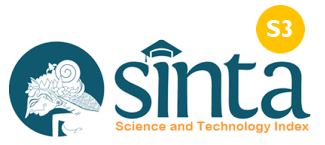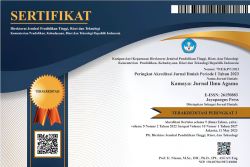Eksistensi Pendidikan Agama Hindu di Era Digital Dalam Memperkuat Karakter Siswa
DOI:
https://doi.org/10.37329/kamaya.v6i4.2748Keywords:
Hindu Religious Education, Character Education, Digital EraAbstract
The rapid development of technology in the digital era is one of the challenges in developing children's character today. Technology has had an impact in terms of the decline in children's character values. Therefore, Hindu religious education is very important in this situation to help students understand and overcome the moral dilemmas that occur in the digital world. This research aims to determine the efforts that need to be made to strengthen student character in the digital era. This research uses a qualitative type of research using a descriptive analysis approach. The results of this research indicate that cyber technology can be used to create learning strategies that encourage students to learn independently, and the character of education must be consistently included in all Hindu religious learning activities. Apart from school teachers, parents also play an important role in directing children to use technology wisely. The character values that can be instilled in Hindu religious teachings are as follows, religious values, tolerance, discipline, independence, curiosity, friendship/communicativeness, caring for the environment and responsibility.
References
Arimbawa, I. A., Atmadja, N. B., & Natajaya, I. (2018). Peran Guru Pendidikan Agama Hindu dalam membangun Nilai Karakter Siswa melalui Implementasi Tri Hita Karana. IVCEJ, 34.
Creswell, J. W. (1998). Qualitative Inquiry and Research Design: Choosing Among Five Traditions. USA: Sage Publications Inc.
Darma, I. W. (2020). Pendidikan Karakter dan Moralitas Berbasis Tat Twam Asi. Haridracarya: Jurnal Pendidikan Agama Hindu, 195.
Dewi, P. A. (2022). Peran Orangtua Dalam Pembentukankarakter Religius Anak Usia 5-6 Tahun Melalui Pengenalan Mantram Puja Trisandya di Masa Belajar Dari Rumah. Pratama Widya, 83.
Gateri, N. W. (2019). Pendidikan Karakter Hindu. Bawi Ayah: Jurnal Pendidikan Agama dan Budaya Hindu, 10(1), 12-24.
Gunawan, I. G. (2017). Pemanfaatan Media Sosial Sebagai Media Pendidikan Agama Hindu. Bawi Ayah: Jurnal Pendidikan Agama Dan Budaya Hindu, 8(2), 16-27.
Hadriani, L. G. (2021). Revitalisasi Nilai Nilai Hukum Hindu Dalam Meningkatkan Kesadaran Hukum Umat Hindu. Hukum dan Kebudayaan, 50-52.
Massie, A. Y. (2021). Dampak pembelajaran daring terhadap pendidikan karakter siswa. Satya Widya, 37(1), 54-61.
Natih, P. A. (2021). Panca Satya Tersirat Dalam Epos Mahabharata Sebagai Pedoman Pendidikan Karakter Generasi Hindu. Guna Widya: Jurnal Pendidikan Hindu, 184.
Paramita, A. A. (2023). Ajaran Catur Paramita Terhadap Pola Pendidikan Karakter Dalam Lontar Siwa Sasana. Wicaksana, 16.
Pinatih, N. P. (2021). Konsep Pembelajaran Agama Hindu di Era Digital. Prosiding Seminar Nasional IAHN-TP Palangka Raya, 108-125.
Pratiwi, N. &. (2017). Pengaruh literasi digital terhadap psikologis anak dan remaja. Semantik, 6(1), 11-24.
Putri, D. P. (2018). Pendidikan karakter pada anak sekolah dasar di era digital. AR-RIAYAH: Jurnal Pendidikan Dasar, 2(1), 37-50.
Santiawan, I. N. (2021). Implementasi Catur Asrama dalam Mencapai Tujuan Hidup (Catur Purusa Artha). Widya Aksara: Jurnal Agama Hindu, 297.
Sherli, P. F. (2022). Penguatan Pendidikan Karakter Pada Siswa Sekolah Dasar Melalui Pemanfaatan Literasi Digital. Jurnal PGSD, 8(1), 58-72.
Straus, A. d. (1990). Basics of qualitative research: Grounded theory procedures and techniques. Newbury Park: Sage.
Sugiyono. (2018). Metode Penelitian Kuantitatif, Kualitatif, dan R&D. Bandung: Alfabeta.
Sukiman, d. (2016). Seri Pendidikan Orang Tua: Mendidik Anak di Era Digital. Jakarta: Kementerian Pendidikan dan Kebudayaan.
Sutarti, T. (2022). Membangun Kepribadian Dan Budi Pekerti Luhur Melalui Penerapan Ajaran Agama Hindu. Jurnal Widya Aksara, 53.
Xue, S. &. (2020). Educational affordances of mobile social media for language teaching and learning: a chinese teacher’s perspective. Computer Assisted Language Learning, 1-30.
Downloads
Published
How to Cite
Issue
Section
License
Copyright (c) 2023 Kamaya: Jurnal Ilmu Agama

This work is licensed under a Creative Commons Attribution-ShareAlike 4.0 International License.
An author who publishes in the Kamaya : Jurnal Ilmu Agama agrees to the following terms:
- Author retains the copyright and grants the journal the right of first publication of the work simultaneously licensed under the Creative Commons Attribution-ShareAlike 4.0 License that allows others to share the work with an acknowledgement of the work's authorship and initial publication in this journal
- Author is able to enter into separate, additional contractual arrangements for the non-exclusive distribution of the journal's published version of the work (e.g., post it to an institutional repository or publish it in a book) with the acknowledgement of its initial publication in this journal.
- Author is permitted and encouraged to post his/her work online (e.g., in institutional repositories or on their website) prior to and during the submission process, as it can lead to productive exchanges, as well as earlier and greater citation of the published work (See The Effect of Open Access).
Read more about the Creative Commons Attribution-ShareAlike 4.0 Licence here: https://creativecommons.org/licenses/by-sa/4.0/.





